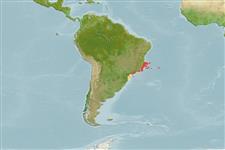Classification / Names
Κοινά ονόματα | Συνώνυμα | Catalog of Fishes(Γένος, Είδη) | ITIS | CoL | WoRMS | Cloffa
>
Eupercaria/misc (Various families in series Eupercaria) >
Scaridae (Parrotfishes) > Sparisomatinae
Etymology: Sparisoma: Latin, sparus = a fish with a golden head + Greek, soma = body (Ref. 45335); tuiupiranga: From the Tupi for 'red parakeet', the native American language once spoken along the Brazilian coast, and refers to the splendid color of initial phase adults of this small parrotfish..
Environment: milieu / climate zone / depth range / distribution range
Οικολογία
Θαλασσινό(ά) Υφαλόφιλο(α); εύρος βάθους 5 - 20 m (Ref. 52151). Subtropical; 17°S - 28°S
Southwestern Atlantic: from the state of Bahia (Abrolhos Archipelago National Marine Park to the state of Santa Catarina), Brazil.
Μέγεθος / Βάρος / Age
Maturity: Lm ? range ? - ? cm
Max length : 15.4 cm SL αρσενικό/απροσδιόριστο; (Ref. 52151)
Found in shallow areas of tropical rocky reefs. Males establish territories (approximately 8 m2). Juveniles are strongly associated with seaweed beds, occasionally found mixed with Sparisoma radians and Cryptotomus roseus. This species is typically a scraper which grazes upon a large variety of epilithic algae (e.g. Jania, Gelidium, Polysiphonia, consequently ingesting a large quantity of sediment. It is however, very plastic in its feeding habits and is commonly observed browsing over Sargassum. Males and larger initial phase adult individuals perform up to 2400 bites daily with a mean gut turnover of about 2.5 guts day-1, having an important role on local energy flux (Ref. 52151).
Life cycle and mating behavior
Γεννητική Ωρίμανση | Αναπαραγωγή | Γεννοβολία | Αβγά | Γονιμότητα | Προνύμφες
Gasparini, J.L., J.-C. Joyeux and S.R. Floeter, 2003. Sparisoma tuiupiranga, a new species of parrotfish (Perciformes: Labroidei: Scaridae) from Brazil, with comments on the evolution of the genus. Zootaxa 384:1-14. (Ref. 52151)
IUCN Red List Status (Ref. 130435)
Threat to humans
Harmless
Human uses
Περισσότερες πληροφορίες
Κοινά ονόματαΣυνώνυμαΜεταβολισμόςΘηρευτέςΟικοτοξικολογίαΑναπαραγωγήΓεννητική ΩρίμανσηΓεννοβολίαΣυναθροίσεις γεννοβολίαςΓονιμότηταΑβγάEgg development
Age/SizeΑύξησηLength-weightLength-lengthLength-frequenciesΜορφομετρίαΜορφολογίαΠρονύμφεςΔυναμική προνυμφώνΣτρατολόγησηΑφθονίαBRUVS
ΑναφορέςΥδατοκαλλιέργειεςΠροφίλ υδατοκαλλιέργειαςΣτελέχοιΓενετικήElectrophoresesΚληρονομικότηταΑσθένειεςΜεταποίησηNutrientsMass conversion
ΣυνεργάτεςΦωτογραφίεςStamps, Coins Misc.ΉχοιΣιγκουατέραΤαχύτηταΚολυμβητικός ΤύποςΕπιφάνεια βραγχίωνOtolithsΕγκέφαλοιΌραση
Εργαλεία
Special reports
Download XML
Διαδικτυακές πηγές
Estimates based on models
Preferred temperature (Ref.
123201): 23.4 - 26.4, mean 25.8 °C (based on 67 cells).
Phylogenetic diversity index (Ref.
82804): PD
50 = 0.5000 [Uniqueness, from 0.5 = low to 2.0 = high].
Bayesian length-weight: a=0.01585 (0.00935 - 0.02687), b=3.13 (2.99 - 3.27), in cm total length, based on LWR estimates for this species & Genus-body shape (Ref.
93245).
Τροφικό Επίπεδο (Ref.
69278): 2.0 ±0.00 se; based on food items.
Ελαστικότητα (Ref.
120179): Υψηλό, ελάχιστος χρόνος για διπλασιασμό πληθυσμού < 15 μήνες (Preliminary K or Fecundity.).
Fishing Vulnerability (Ref.
59153): Low vulnerability (10 of 100).
